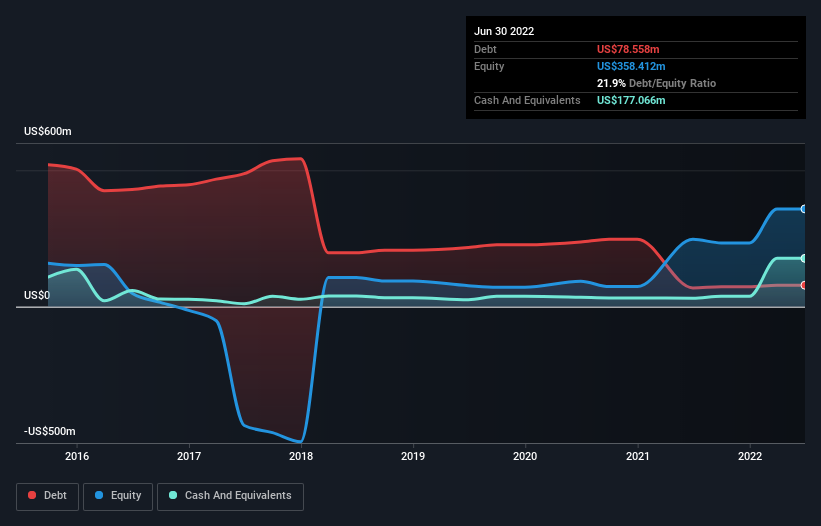The external fund manager backed by Berkshire Hathaway's Charlie Munger, Li Lu, makes no bones about it when he says 'The biggest investment risk is not the volatility of prices, but whether you will suffer a permanent loss of capital.' So it might be obvious that you need to consider debt, when you think about how risky any given stock is, because too much debt can sink a company. We can see that Paladin Energy Ltd (ASX:PDN) does use debt in its business. But should shareholders be worried about its use of debt?
Why Does Debt Bring Risk?
Debt and other liabilities become risky for a business when it cannot easily fulfill those obligations, either with free cash flow or by raising capital at an attractive price. If things get really bad, the lenders can take control of the business. While that is not too common, we often do see indebted companies permanently diluting shareholders because lenders force them to raise capital at a distressed price. Having said that, the most common situation is where a company manages its debt reasonably well - and to its own advantage. When we examine debt levels, we first consider both cash and debt levels, together.
See our latest analysis for Paladin Energy
What Is Paladin Energy's Net Debt?
You can click the graphic below for the historical numbers, but it shows that as of June 2022 Paladin Energy had US$78.6m of debt, an increase on US$68.7m, over one year. But on the other hand it also has US$177.1m in cash, leading to a US$98.5m net cash position.

How Healthy Is Paladin Energy's Balance Sheet?
Zooming in on the latest balance sheet data, we can see that Paladin Energy had liabilities of US$2.60m due within 12 months and liabilities of US$120.0m due beyond that. Offsetting this, it had US$177.1m in cash and US$5.08m in receivables that were due within 12 months. So it can boast US$59.6m more liquid assets than total liabilities.
This short term liquidity is a sign that Paladin Energy could probably pay off its debt with ease, as its balance sheet is far from stretched. Succinctly put, Paladin Energy boasts net cash, so it's fair to say it does not have a heavy debt load! The balance sheet is clearly the area to focus on when you are analysing debt. But it is future earnings, more than anything, that will determine Paladin Energy's ability to maintain a healthy balance sheet going forward. So if you want to see what the professionals think, you might find this free report on analyst profit forecasts to be interesting.
In the last year Paladin Energy wasn't profitable at an EBIT level, but managed to grow its revenue by 57%, to US$4.7m. Shareholders probably have their fingers crossed that it can grow its way to profits.
So How Risky Is Paladin Energy?
We have no doubt that loss making companies are, in general, riskier than profitable ones. And in the last year Paladin Energy had an earnings before interest and tax (EBIT) loss, truth be told. And over the same period it saw negative free cash outflow of US$8.0m and booked a US$27m accounting loss. But the saving grace is the US$98.5m on the balance sheet. That kitty means the company can keep spending for growth for at least two years, at current rates. With very solid revenue growth in the last year, Paladin Energy may be on a path to profitability. By investing before those profits, shareholders take on more risk in the hope of bigger rewards. When analysing debt levels, the balance sheet is the obvious place to start. However, not all investment risk resides within the balance sheet - far from it. For instance, we've identified 2 warning signs for Paladin Energy that you should be aware of.
At the end of the day, it's often better to focus on companies that are free from net debt. You can access our special list of such companies (all with a track record of profit growth). It's free.
New: Manage All Your Stock Portfolios in One Place
We've created the ultimate portfolio companion for stock investors, and it's free.
• Connect an unlimited number of Portfolios and see your total in one currency
• Be alerted to new Warning Signs or Risks via email or mobile
• Track the Fair Value of your stocks
Have feedback on this article? Concerned about the content? Get in touch with us directly. Alternatively, email editorial-team (at) simplywallst.com.
This article by Simply Wall St is general in nature. We provide commentary based on historical data and analyst forecasts only using an unbiased methodology and our articles are not intended to be financial advice. It does not constitute a recommendation to buy or sell any stock, and does not take account of your objectives, or your financial situation. We aim to bring you long-term focused analysis driven by fundamental data. Note that our analysis may not factor in the latest price-sensitive company announcements or qualitative material. Simply Wall St has no position in any stocks mentioned.
About ASX:PDN
Paladin Energy
Through its subsidiaries, engages in the development and exploration of mineral properties in Australia, Canada, and Namibia.
High growth potential with adequate balance sheet.
Similar Companies
Market Insights
Community Narratives




